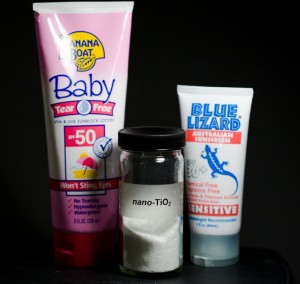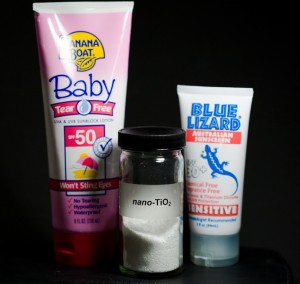 Nanoparticles are already used in many sunscreens.(Photo: Alex Parlini, Proj. on Emerging Nanotechnologies)One month ago, the Committee on Environment, Health and Consumer Protection of the European Parliament voted in favor of excluding nanotechnology from the EU list of novel foods allowed on the market. This committee vote represents one of the first times ever that a legislative body has weighed in on the issue of nanotech particles in food. (Nanotechnology refers to materials or devices developed on an atomic or molecular scale, sized between 1 to 100 nanometers — basically, really, really, really tiny novel particles that our skin and other organs have never before encountered at this scale.)
Nanoparticles are already used in many sunscreens.(Photo: Alex Parlini, Proj. on Emerging Nanotechnologies)One month ago, the Committee on Environment, Health and Consumer Protection of the European Parliament voted in favor of excluding nanotechnology from the EU list of novel foods allowed on the market. This committee vote represents one of the first times ever that a legislative body has weighed in on the issue of nanotech particles in food. (Nanotechnology refers to materials or devices developed on an atomic or molecular scale, sized between 1 to 100 nanometers — basically, really, really, really tiny novel particles that our skin and other organs have never before encountered at this scale.)
For those of us watching how government views nanotechnology, this was welcome news.
Whether we are focusing on food or other consumer goods, so far more than a thousand products containing nanoparticles are currently available in the U.S. These nano-enabled products have been put on the market without testing their possible impacts on human health or the environment. And, without stringent government review and without regulation, these products are foisted on an unsuspecting public. People are using nanotechnology, such as sunscreen containing nanoparticles of zinc oxide, on a daily basis, almost completely unaware of what they’re putting on their bodies.
In some cases, nanotechnology has proven benefits, but without a clear understanding of the health and environmental impacts, how can the Environmental Protection Agency, the Food and Drug Administration, and the public assess whether or not use of nanotech products is worth the risks? Nanotechnology practically cries out for regulation.
It is a clear, prudent recognition of the overwhelming need for testing in the name of public safety.
That’s what’s encouraging about the European Parliament committee’s action, which also included a declaration that food produced from nanotechnology processes must undergo risk assessment before being approved for use and must be labeled on packaging. The decision was approved by the influential committee almost unanimously, with 42 votes in favor, two against, and three abstentions. While the final plenary vote on the issue is expected to take place in the European Parliament in July, the lopsided committee vote speaks to the absolute logic of such a move. It is a clear, prudent recognition of the overwhelming need for testing in the name of public safety.
It now looks as though U.S. regulatory agencies may be coming around to the point of view that testing should not be considered a burden, but rather an urgent need. The EPA is promising that it will release proposed regulations on nano pesticides soon. We hope the regulations will require companies to report the presence of nano-silver and other nanomaterials in hundreds of consumer products ranging from children’s pacifiers to athletic clothing.
EPA has broad authority under the Federal Insecticide, Fungicide, and Rodenticide Act (FIFRA) over all substances intended to kill pests, including germ killers, but has not addressed until now the growing nano-silver market (primarily as an anti-microbial agent in food packaging), or the market for most other nanochemicals. The proposed rules would be a response to a legal petition filed with the EPA by the International Center for Technology Assessment and the Center for Food Safety in May of 2008, on behalf of a coalition of 12 other public interest organizations, calling on EPA to regulate nano-silver products as pesticides.
The nanotechnology industry often touts the benefits to humanity that their discoveries and applications have created. Lawmakers and regulators should carefully review those real advances, but with balance and logic. We shouldn’t rush to include technology in foods and other products without a clear understanding of the long-term risks these products may pose. The European Commission should follow the directive of the Parliament and to put strong policies in place that will adequately protect human health and the environment from the potential hazards of these novel products. And in the U.S., the EPA and the FDA should do likewise.


